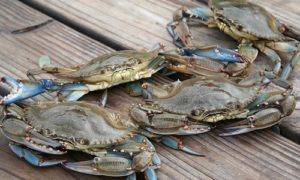How to Catch Blue Crabs
Delicious and Dangerous
Early to rise or late to get rolling, it doesn’t matter for catching crabs. Use the tide as your guide, and remember your gloves. A thick pair of gloves is important when handling crabs. These tasty shellfish are only good when cooked alive and that means dealing with claws. Just as important to remember are traps, proper bait and location.
When setting up traps for crabbing it is important to have an easy way to attach and secure your bait. Using springs and snoods are effective way to do both without needing tools. You can slide the bait into the snood and pull tight to secure it. The spring will keep the bait secure to your trap. These work well when you need to quickly remove the bait to replace it or store your catch.
As for bait, blue crabs are scavengers that find their food by smell. Picking up chicken necks from farms or clams the morning of or day before your trip will provide a more attractive bait. Frozen bait keeps for longer, while you can use it for your traps it will be to your advantage to try the fresh first. It will depend on your preference and the volume of crabs in the area. Keep a separate container to store the spent bait separately so that it doesn’t repel the crabs and you don’t repel people.
Now the type of trap should be heavy enough to sink and stay on the bottom, you can’t catch them if they can’t reach the bait. Or if you are in an area that does not require traps then you should use weighted bait or bone in chicken parts to ensure that it stays down. After the traps or your bait is weighted make sure you have a long enough rope by keeping note of the depth reported for the area. You will also want to make sure of the tides for the area; blue crabs move with the water so this should be completed before the tide comes in. Morning or evening tide, it doesn’t matter, so don’t worry if you get caught in traffic.
Speaking of caught, check your traps about every six hours; you don’t want your catch to turn on each other once the bait is gone. Now that you’ve caught your crabs, this is where your thick gloves come into use. When handling your catch remember to hold them by grabbing the back top and bottom of their body; their claws can reach around their bodies a bit. Place the crabs in a good size container for storing your catch because blue crabs will fight each other to the death if kept in close spaces. Make sure to have extra bait to keep the crabs alive until your dinner, freezing them would be good idea if possible. All that’s left to do now is enjoy your catch!
by LA DiNardi with Victoria Stamp






Follow Us!